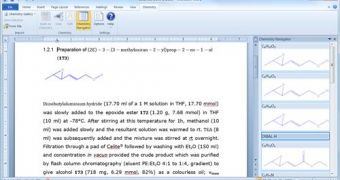Citing the need to support the ability of chemists to communicate in their discipline-specific language as essential to scientific research, Microsoft has made available for download a free add-in for the 2010 and 2007 flavors of Office Word. Dubbed informally Chem4Word, the add-in was developed by Microsoft Research and the Unilever Centre for Molecular Science Informatics at the University of Cambridge, and was released at the American Chemical Society’s Spring 2010 National Meeting & Exposition. Alex Wade, director for Scholarly Communication, Microsoft Research, explained that the Word extension was capable of supporting specific symbols across technologies and file formats, and streamlining authoring and semantic annotation.
“Chem4Word makes it easier for students, chemists and researchers to insert and modify chemical information, such as labels, formulas and 2-D depictions, from within Microsoft Office Word. Designed for and tested on both Word 2007 and Word 2010, it harnesses the power of Chemical Markup Language (XML for chemistry), making it possible not only to author chemical content in Word, but also to include the data behind those structures. Chem4Word and Chemical Markup Language make chemistry documents open, readable and easily accessible, not just to other humans, but also to other technologies,” Wade explained.
Although the Chemistry Add-in for Word is essentially designed to integrate seamlessly with both 2010 and 2007 flavors of Office Word, the software giant noted that early adopters running the Beta development milestone of Word 2010 wouldn’t be able to leverage it. According to Wade, Microsoft plans to make the add-in available as an open-source project via CodePlex. The company indicated that the project would be published under an Apache license by the end of 2010.
“In addition to authoring functionality, Chem4Word enables user denotation of inline 'chemical zones,' the rendering of high-quality and print-ready visual depictions of chemical structures and the ability to store and expose semantic-rich chemical information across the global chemistry community,” Wade added. “2007. We also have taken advantage of user-interface extensibility and XML features already included in Office 2007 and Office 2010, and we hope this provides a demonstration of the power of Microsoft Office as a platform. Microsoft Research worked closely with key individuals in the field of chemistry to develop this tool, but Microsoft Office provides the tools and resources to enable other domains to develop on top of Office applications.”
Chemistry Add-in for Word is available for download here.

 14 DAY TRIAL //
14 DAY TRIAL //